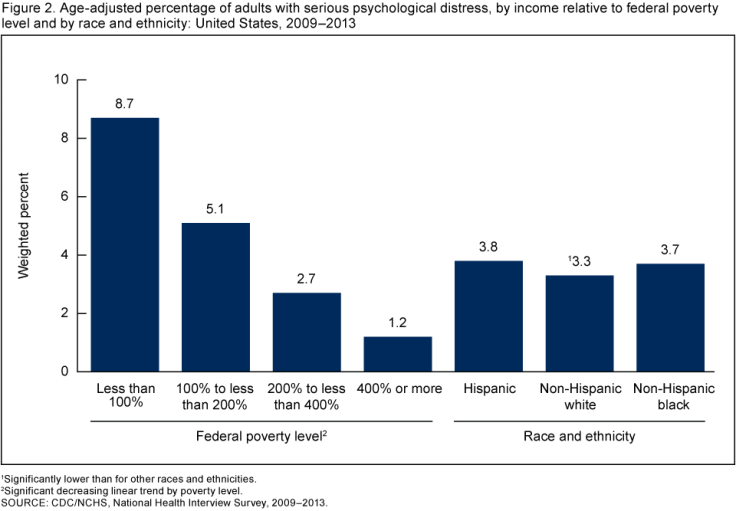Chronic Stress Is Killing People In Poverty, Women Especially: CDC Report

A new report from the Centers for Disease Control and Prevention shows a life of poverty may be more devastating to people’s psychological and physical health than previously thought.
Awash in scientific experiments and sociological findings, from the “cycle of poverty” coined in the 1960s to the more general “culture of poverty” that came several decades later, research into what makes the experience of being poor so harmful has yielded massive insights. Much of the research may, in fact, undersell the true statistics, given the controversy surrounding the federal government’s formal definition of poverty.
The CDC’s new report analyzes data collected between 2009 and 2013. It found that, at all ages, women experienced more serious psychological stress than men, and younger age groups tended to show more stress than older cohorts. But perhaps the most telling statistic from the set was the disparity between income levels: A total of 8.7 percent of people below the federal poverty line, defined as an annual income of $11,770 for a single person and $24,250 for a family of four, experienced serious psychological distress, while only 1.2 percent of people at or above 400 percent of the poverty line suffered the same.

The best research upholds what anecdotal evidence has shown for years, that poverty is cyclical and highly detrimental to long-term physical and emotional well-being.
For starters, poverty is loud. Thin-walled apartments do little to muffle the sounds of crime, domestic violence, and other late-night activity. In 2013, scientists found all that noise can have a damaging effect on children’s auditory processing. Elsewhere in the brain, poverty eats away at people’s intelligence. A study published just a couple months prior to the findings on hearing showed dramatic declines in IQ for people living in poverty, regardless of whether they lacked money or crops.
The CDC’s report also suggested egregious physical effects. Adults experiencing psychological stress more frequently suffered from chronic obstructive pulmonary disease, heart disease, and diabetes compared to adults without serious psychological distress. Heart disease is particularly worrying, as it’s currently the leading cause of death in men and women in the U.S., making up a quarter of all deaths annually. Without access to fresh fruits and vegetables, many in poverty turn to unhealthy processed foods to stay full.
More alarming, these changes aren’t necessarily temporary. The romantic ideals of a family extricating itself from the grips of drugs and crime to flourish in well-lit suburbs may be exaggerated, according to the science on how poverty changes people’s genes. When scientists looked at more than 20,000 sites in the human genome among 3,000 people, they found people who grew up in poverty had vastly different gene expressions than people who matured with money. To the researchers, the conclusion was clear: Poverty can leave lasting impressions on a person’s DNA, even after money stops being a factor.
All that research seems to leave little room for hope, which helps explain why the cycle is so hard to break. Even with the necessary grit and dedication, environmental factors often pose too great an obstacle for families, forcing them to choose between a life of law-abiding suffering or success built on illegal means. No matter the case, the cycle continues.
At the least, that is what scientists turn to when they push for public health policy aimed at relieving the poor of their burden. Poverty, research has come to understand, isn’t a choice as much as it is a congenital disease, packed with hormone imbalances and genetic handicaps. The only way out is a helping hand offering treatment.
Published by Medicaldaily.com



























